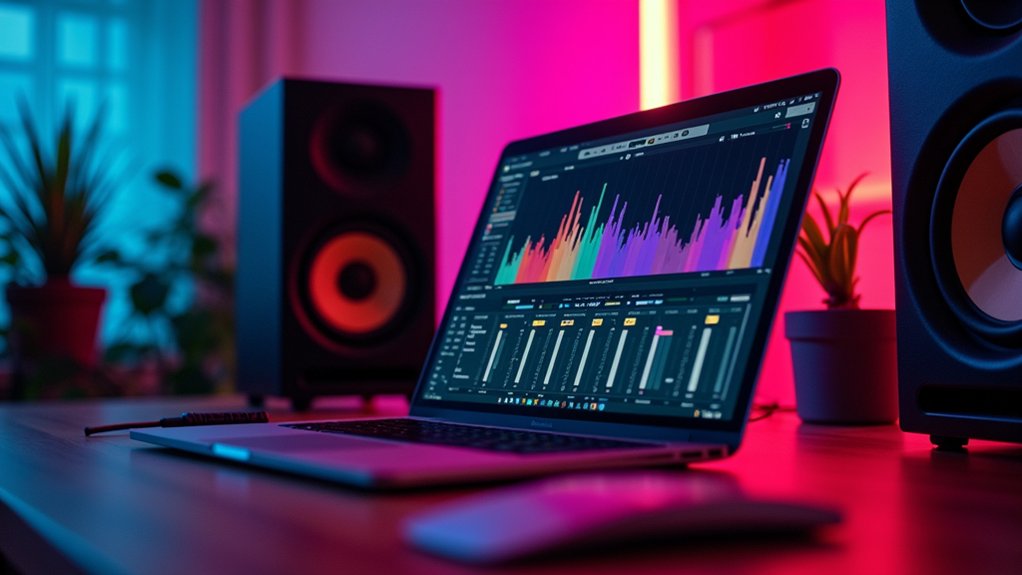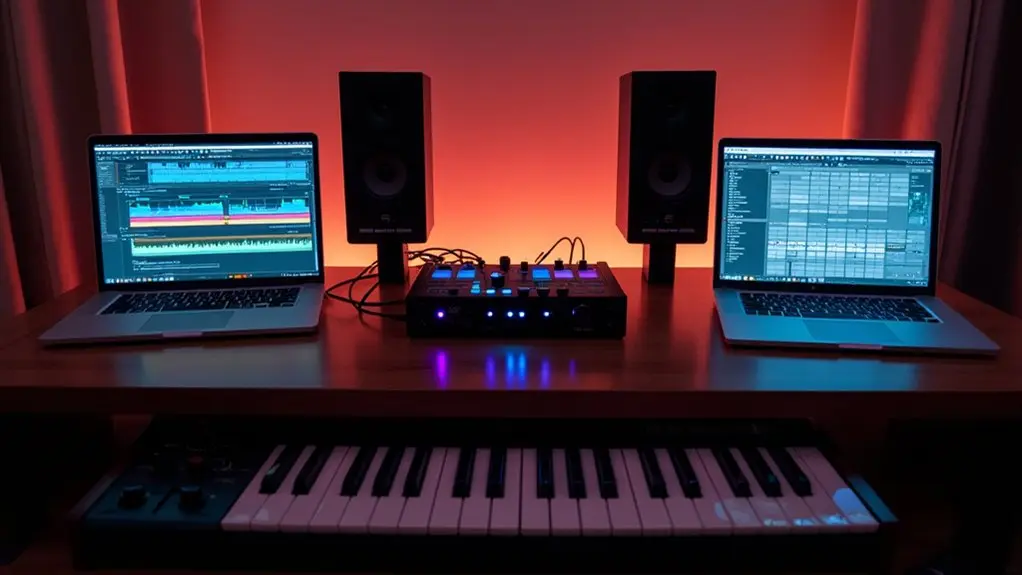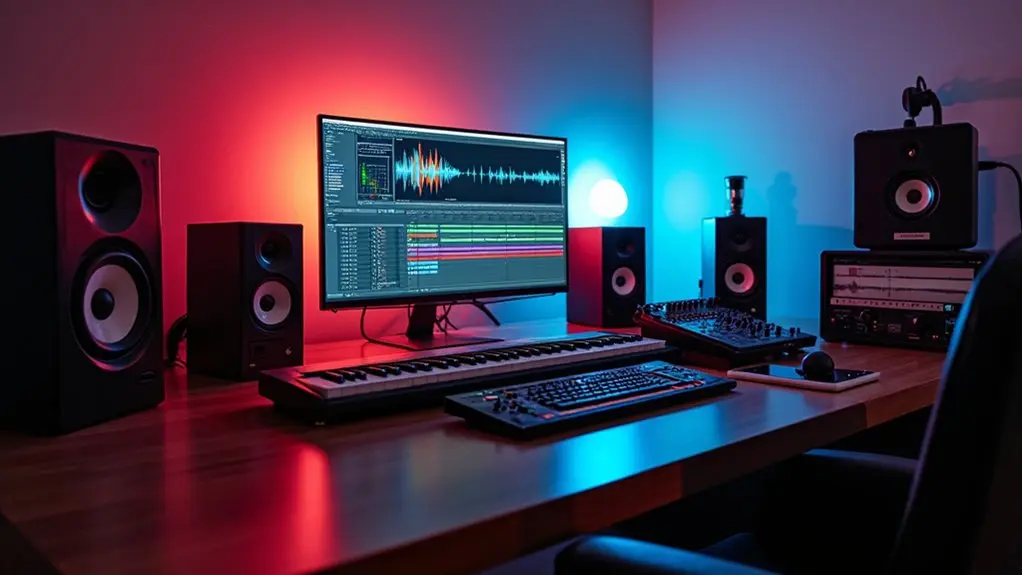Bitwig Studio excels in modularity and advanced modulation, ideal for users prioritizing deep customization and intricate sound design. Ableton Live stands out with its dual-view interface, offering streamlined workflow and superior performance integration for rapid production and live sets. Both DAWs support efficient sample browsing and MPE, but differ in plugin formats and platform compatibility. Choice depends on whether the workflow demands granular control or immediate, performance-oriented production. A detailed breakdown of strengths awaits below.
Key Takeaways
- Bitwig Studio offers a highly modular environment and advanced modulation, ideal for intricate sound design and customization.
- Ableton Live’s dual-view system excels in live performance and rapid loop-based production, emphasizing immediacy and ease of use.
- Bitwig’s customizable interface and contextual browser enable flexible workflows and simultaneous clip and timeline editing.
- Ableton Live provides superior hardware integration, especially with Push, and includes a broader selection of built-in devices and effects.
- Bitwig supports Windows, macOS, and Linux, while Ableton Live offers lifetime updates but does not support Linux.
Overview of Bitwig Studio and Ableton Live
While both Bitwig Studio and Ableton Live are leading digital audio workstations designed for music production and performance, their core workflows and feature sets cater to distinct user preferences.
Bitwig Studio is characterized by its modular design, offering granular control and an advanced modulation system that appeals to users focused on experimental sound design and customization. Its audio engine and flexible routing options provide a robust foundation for intricate production workflows.
In contrast, Ableton Live emphasizes an intuitive approach, with its hallmark dual-view system enabling seamless shifts between arrangement and session views—optimizing both live performance and studio composition. Ableton Live’s Session View enables spontaneous clip launching for real-time experimentation and non-linear composition, making it a favorite among musicians for dynamic performance capabilities.
Recent updates underscore these differences: Bitwig 5.3 introduced new drum devices, expanding beat creation tools, while Ableton Live 12.1.5 added Auto Shift for real-time pitch correction.
User Interface and Workflow Comparison
When comparing user interface and workflow, Bitwig Studio’s customizable layout and integrated Inspector Panel contrast with Ableton Live’s structured dual-view system, each influencing different approaches to project navigation.
Bitwig’s capability to display the clip launcher alongside the timeline maximizes simultaneous editing, while Ableton’s streamlined switch between Session and Arrangement Views prioritizes rapid loop-based production.
Workflow speed and flexibility are further shaped by each DAW’s unique modulation systems and drag-and-drop functionalities, catering to varying user preferences in creative efficiency.
Layout and Panel Customization
The layout and panel customization capabilities in Bitwig Studio and Ableton Live reflect distinct philosophies in user interface and workflow design.
Bitwig Studio emphasizes workflow flexibility, offering a modular design that enables users to rearrange panels, dock windows, and utilize an Inspector Panel for streamlined editing of audio and MIDI tracks. This modularity allows simultaneous access to the clip launcher and timeline, facilitating complex creative processes.
In contrast, Ableton Live adopts a dual-view architecture—Session View and Arrangement View—providing a clean, minimalist interface optimized for rapid switching and hardware integration. While Ableton’s layout and panel customization is more fixed, its intuitive design supports an efficient linear workflow.
Both DAWs feature efficient browsing, but Bitwig’s contextual browser enhances adaptive workflow precision.
Clip Launcher Versatility
Building upon the distinct approaches to layout and customization, Bitwig Studio and Ableton Live both center their creative workflows around a powerful clip launcher, integral to non-linear music production.
Bitwig’s clip launcher stands out for its flexible panel arrangements and the inclusion of an Inspector Panel, providing detailed editing of audio and MIDI clips directly within the workflow. This seamless integration enables simultaneous manipulation of both clip launching and timeline editing, contributing to a highly adaptive environment.
Conversely, Ableton Live’s Session View remains a benchmark for rapid idea generation and performance, with its intuitive interface and efficient toggling between the clip launcher and Arrangement View.
While both DAWs excel in facilitating dynamic composition, Live’s strong hardware integration and established workflow continue to appeal to performance-focused producers.
Workflow Speed and Flexibility
Although both Bitwig Studio and Ableton Live are engineered for fast, adaptive music creation, their user interface philosophies diverge markedly, directly influencing workflow efficiency and flexibility. Bitwig’s highly customizable user interface empowers users to tailor panel layouts, supporting a personalized workflow particularly suited to advanced production scenarios. In contrast, Ableton’s dual-view system—Session and Arrangement Views—caters to seamless shifts between live performance and linear production, prioritizing workflow speed and accessibility. Bitwig offers simultaneous control of audio and MIDI tracks, maximizing flexibility, whereas Ableton’s streamlined design and fixed browser emphasize ease of use. Bitwig’s inspector panel simplifies complex features, while Ableton’s minimalist interface reduces visual complexity. Both DAWs deliver robust browsing and workflow features, but their approaches distinctly shape audio and MIDI production experiences.
| Feature | Bitwig Studio | Ableton Live |
|---|---|---|
| UI Customization | Highly configurable | Fixed dual-view system |
| Audio/MIDI Control | Simultaneous | Separated |
| Learning Curve | Steep, modular flexibility | Beginner-friendly |
| Browsing | Contextual pop-up | Fixed left-side panel |
| Workflow Focus | Advanced, tailored production | Fast, intuitive performance |
Modulation, Automation, and Sound Design
Elevating modulation, automation, and sound design, Bitwig Studio distinguishes itself with an advanced modulation architecture that enables users to route modulation sources to virtually any device parameter, including those within third-party plugins.
This modular flexibility, exemplified by Bitwig’s Grid tools (Poly Grid, FX Grid, Note Grid), allows for deep customization and workflow efficiency in constructing bespoke effects and instruments.
In contrast, Ableton Live offers robust automation across dedicated lanes and audio clips, with precise control, making it ideal for dynamic shifts and live performance.
Live’s MIDI capabilities, such as note folding and Capture MIDI, further streamline creative processes and generative sound design.
Both DAWs support MPE, but Bitwig enhances MIDI sound manipulation with additional Note FX processors.
- Bitwig’s modulation system covers all device and plugin parameters
- Ableton Live excels in automation and clip-based workflow
- Both integrate advanced MIDI and MPE for expressive sound design
MIDI Editing and Sequencing Capabilities
A critical comparison of MIDI editing and sequencing reveals distinct workflow strengths in both Bitwig Studio and Ableton Live.
Bitwig Studio’s detailed piano roll editor, featuring micro-pitch editing and MIDI comping, offers granular control over note grid manipulation, supporting a modular environment where advanced MIDI editing integrates seamlessly with its unified modulation system. This enables dynamic modulation of MIDI parameters in real time, fostering evolving sequences.
Ableton Live emphasizes immediacy with features like Capture MIDI, which retroactively records ideas, and robust MIDI effects that streamline sequencing. The dual-view system—Session and Arrangement Views—accommodates both improvisational and linear workflows, enhancing adaptability. Ableton Live’s automation techniques enable dynamic manipulation of sound parameters over time, further enriching the sequencing process.
Both DAWs support MPE, catering to expressive sequencing, but their approaches to workflow and precision differ markedly, shaping user preference.
Devices, Plugins, and Browser Functionality
When comparing device selection and variety, Bitwig emphasizes modularity with its Grid environment, while Ableton focuses on a suite of integrated instruments and effects.
Both platforms offer broad plugin compatibility, though Bitwig’s inclusion of the CLAP format contrasts with Ableton’s AU support.
Browser navigation is streamlined in each DAW, with Bitwig providing contextual pop-up access and Ableton favoring a fixed, left-panel layout for rapid content management.
Device Selection and Variety
Device selection and variety play a critical role in shaping the creative workflow within both Bitwig Studio and Ableton Live.
Bitwig adopts a modular approach, offering tools like Poly Grid and Note Grid for crafting custom instruments and effects, fostering deep creative sound manipulation. Its device selection is further enhanced by extensive modulation capabilities, which can be applied to nearly any parameter.
Ableton Live, on the other hand, emphasizes immediacy and ease of use through a broad selection of built-in devices, while Suite users access Max for Live to develop bespoke tools.
Both DAWs support VST plugins, yet Bitwig also introduces the CLAP format for expanded compatibility.
- Bitwig enables granular device customization via modular environments
- Ableton Live provides intuitive built-in devices for rapid workflow
- Both integrate VST plugins, with Bitwig supporting CLAP for broader device variety
Plugin Compatibility Overview
Plugin compatibility forms an essential axis in evaluating workflow flexibility between Bitwig Studio and Ableton Live.
Bitwig Studio supports VST2, VST3, and its proprietary CLAP format, ensuring robust integration with third-party plugins, while Ableton Live extends compatibility further by additionally supporting AUv2 and AUv3 formats. This broader plugin compatibility overview favors users operating across macOS environments reliant on Audio Units.
Bitwig’s modular Grid tools facilitate deep customization of devices and effects, advancing sound design within the digital audio workstation, whereas Ableton Live emphasizes a more conventional device approach and excels in hardware integration, particularly with its Push 2 controller.
Both DAWs feature extensive device suites and accommodate diverse plugin formats, but their workflows diverge in modularity versus hardware-centric production strategies.
A significant aspect of digital audio workstation workflow is the efficiency with which users can navigate devices, plugins, and sound libraries.
Bitwig Studio offers a customizable browser that appears as a pop-up, enabling contextual access to folders and heightening browser navigation efficiency according to user workflow. This adaptive approach allows users to refine their searches based on device context, which is advantageous for rapid sound design or arrangement.
Ableton Live, on the other hand, employs a fixed browser on the left panel, supporting categorized folders and a robust search function. Both DAWs utilize drag-and-drop functionality to expedite adding samples, presets, and plugins.
Key browser navigation efficiency distinctions include:
- Customizable browser pop-ups (Bitwig Studio)
- Categorized folders and search (Ableton Live)
- Flexible drag-and-drop functionality (Both DAWs)
Pricing, Editions, and System Compatibility
Among contemporary digital audio workstations, Bitwig Studio and Ableton Live present distinct approaches to pricing, editions, and platform compatibility.
Bitwig Studio offers three editions—Essentials ($99), Producer ($199), and Studio ($399)—all featuring a one-year update plan for ongoing software improvements. In contrast, Ableton Live’s editions—Intro ($99), Standard ($449), and Suite ($749)—provide lifetime updates for the purchased version.
Compatibility diverges as well: Bitwig Studio supports Windows, macOS, and uniquely, Linux, addressing workflows requiring Linux support, while Ableton Live excludes Linux.
Both DAWs facilitate robust plugin integration, supporting VST2 and VST3 plugins; Bitwig additionally accommodates CLAP format plugins.
Regarding sound content, Ableton Live Suite delivers 30 Packs, while Bitwig Studio includes 43, offering broader palette options for content-driven workflows.
Choosing the Best DAW for Your Needs
When evaluating which DAW best aligns with specific production objectives, the core differences between Bitwig Studio and Ableton Live become clear through their workflow philosophies and feature sets.
Bitwig Studio excels with its modular environment and advanced modulation, appealing to producers prioritizing deep customization in music production.
Conversely, Ableton Live’s dual-view interface and extensive MIDI controller compatibility—particularly with hardware like Push 2—make it exceptionally user-friendly and ideal for live performance.
Both platforms provide efficient sample browsing, but Bitwig’s contextual customization offers further workflow refinement.
Ableton Live offers advanced production tools like multitrack MIDI editing and real-time clip manipulation, making it suitable for both live performances and detailed sound design.
Pricing structures for both DAWs start at accessible entry points, allowing flexibility based on user needs.
- Bitwig Studio favors modular workflows and sound design innovation.
- Ableton Live stands out for live performance and intuitive operation.
- Both support diverse MIDI controllers for dynamic studio setups.
Frequently Asked Questions
Which DAW Has the Easiest Workflow?
When conducting a workflow comparison, Ableton’s streamlined user interface and feature accessibility generally offer a lower learning curve, while Bitwig’s customization options and advanced audio editing, MIDI capabilities, and collaboration tools favor experienced users seeking performance efficiency.
Which DAW Is Better Than Ableton?
When evaluating which DAW is superior, Bitwig features advanced modulation, flexible user interface, and unique MIDI capabilities, while Ableton advantages include robust plugin compatibility, streamlined audio editing, larger community support, frequent updates, and competitive pricing comparison.
Which DAW Is Best for Mixing and Mastering?
Selecting the best DAW for mixing and mastering depends on mixing techniques, mastering tools, audio effects, track organization, plugin compatibility, sound quality, automation features, collaboration options, and user experience, with each platform offering unique workflow advantages and technical strengths.
What DAW Is Best for Live Performance?
For live performance, a DAW excelling in live loopers, advanced performance features, flexible MIDI mapping, real-time audio manipulation, efficient setlists management, robust controller compatibility, streamlined user interface, and powerful improvisational tools is preferred, while sound design depth remains essential.
Conclusion
In conclusion, both Bitwig Studio and Ableton Live offer robust, workflow-centric environments tailored to distinct production styles. Bitwig excels in modular modulation, flexible routing, and innovative sound design, whereas Ableton provides a mature ecosystem with fast session workflows and deep integration for live performance. The best DAW hinges on the user’s priorities—modularity and experimentation favor Bitwig, while streamlined arrangement and established third-party support make Ableton a compelling choice for many producers.




